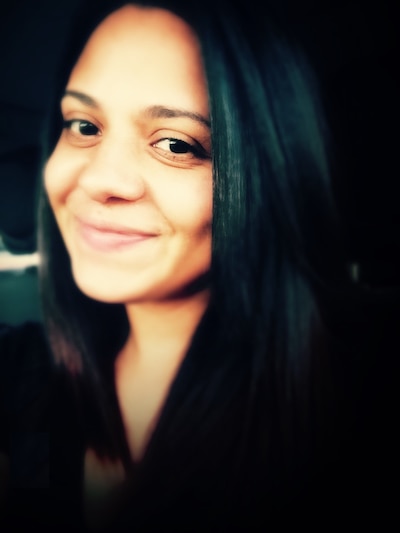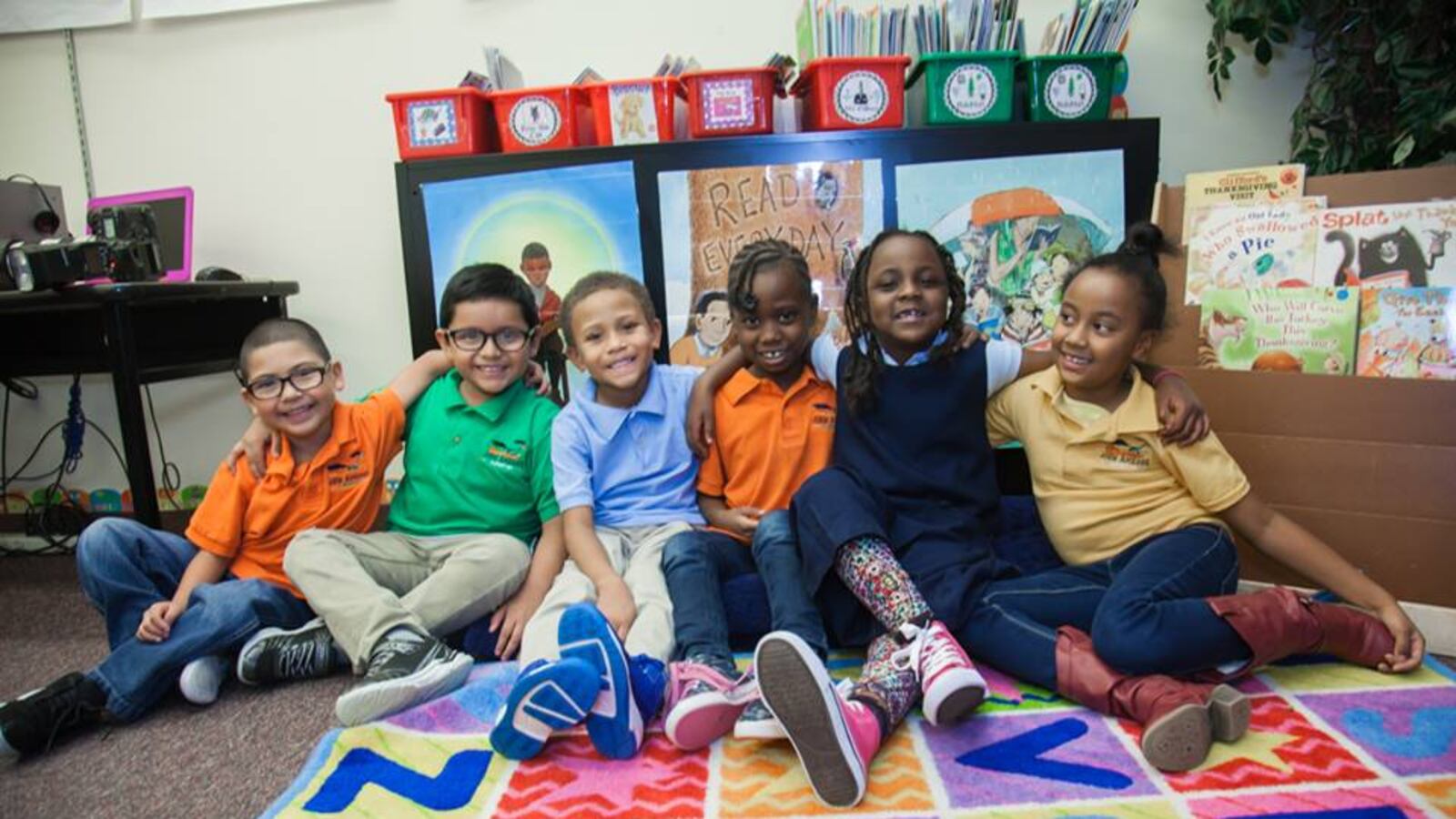Today is the first official day of school in Denver. But students at John H. Amesse Elementary in the far northeast part of the city got a head start when they returned to class last week.

The school is undergoing a “restart” this year in an attempt to improve chronically low student test scores. John H. Amesse has a new principal, a new plan, and new flexibility over how it spends its money and time. (Hence, the early start; research has shown more time in school can boost scores for students from low-income families.) The school also has a slightly new name: It now includes the middle initial H. We sat down with new principal Angelina Walker to talk about her passion for working in the city where she grew up and her vision for John H. Amesse, where nearly all students come from low-income families. Walker spent a year preparing for her new role. While an interim principal handled the day-to-day operations last year, Walker learned, planned, and strategized for this one as part of a turnaround strategy Denver Public Schools calls “year zero.”
“I’ve always wanted to be an educator,” she told Chalkbeat. “I knew from when I was 2 years old that I was going to be teacher. And I knew I wanted to be a teacher that opened a school. So it’s kind of just really serendipitous, but also I feel pretty privileged and blessed.”
This interview has been edited for length and clarity.
What drew you to teaching, even when you were 2?
They talk about callings. I can’t describe it. I just knew. I don’t have educators in my family, so I’m not sure where it came from. But any game I ever played, anything like that, was teaching.
Did you go to school when you were very little?
I did. I’m a Denver native. I grew up in the northeast, far northeast area. When I was real little, I grew up in Park Hill, off of 35th and Elm, and I went to a little day care-slash-school a block away called Watch-Care Academy. It was a predominantly African-American school.
You said that when you applied to become a principal in Denver Public Schools, you asked to lead a school in the northeast because you wanted to serve the community where you grew up. Tell me a bit about what this community means to you.
My community means a lot to me. When I grew up – and this was back in ‘80s and ‘90s, and into the 2000’s for high school – the image that was out there, whether true or not, was that the public education system, at least in the northeast, was not that great, was unsafe.
There was a lot of gang violence, a lot of issues with our community. And out of everybody that I lived with or grew up with, I’m one of the very few that graduated high school. I have a lot of people I grew up with who are creating a life for themselves where they are, so I applaud them. But I have also seen some of the inequities in terms of society.
The importance my family placed on education really impacted and shaped the direction that I went. I mean, it did help that I loved education and I loved teaching. But being able to provide a schooling environment in my neighborhood that challenges what anybody says about our community is of utmost importance to me. Us writing our own narratives, instead of people writing our narratives for us, is very important to me.
I got into education because I wanted to be a teacher. Not necessarily to help, but just to educate, to teach. I became a principal to challenge systemic inequities. My community, they deserve the best. And so they deserve the best leader.
What have some of the challenges been at John Amesse?
Some of challenges that, generally, I have seen are lack of resources. With this turnaround, it’s really refreshing because I have gotten some resources to give kids what they deserve.
We are building a STEAM lab. (STEAM stands for science, technology, engineering, art, and math.) We have a lot of social and emotional supports. Right now, we have a psychologist, a social worker, and a social work intern. We have three members on our special education team, a full-time nurse, and the Center for Family Opportunity.
There’s a narrative out there about John Amesse that it was “a mess.” I think that the last couple of years, it’s really changed around. So really reclaiming that narrative is important.
I do think that we’ll continue – and then accelerate even more – with what the previous principal, Charmaine, did in terms of starting to look at our instruction based off of our data. So just bringing in some of those systems and tightening those up some, and having teachers own that.
We also want to maintain the culture that’s been built here. John Amesse has a wonderful, amazing culture. It’s just beautiful to walk around the school when the kids are here.
What are some of the things that make it special?
The involvement with the community has always been something that I value and I will strive hard to continue. Just celebrating kids. (In previous years, the school) did little things that we’re continuing, like celebrating attendance or shouting-out kids.
We plan on continuing a lot of the traditions – white linen lunches, and different things for kids – and adding on to them awards assemblies and things like that.
What’s a white linen lunch?
A white linen lunch is for students that have a certain percentage for their attendance. Basically, they get their lunch served to them on white linen cloths. They love it. There’s little decorations and then they get a little dessert at the end.
Can you think of an example of a really impactful conversation with a student or with a family that informed your work during your ‘year zero’?
There were a couple. I had a – we called them pop-up sessions – with a group of kids. We were in the new STEAM lab, but it was just that big, open space.
The question I put out there was, ‘If you could imagine this space to be anything you wanted it to be, what would you make it as and why?’ Then they had to create, from cut-out magazines, these pictures showing what they wanted in the space.
At first, I thought they wanted a makerspace type of area, and that’s where we were heading originally. And it basically came out that they wanted a space where they could build and explode and do different things like that – and they wanted a space where literacy was involved. Literacy, including drama and the arts.
Taking all their suggestions, I started researching and the STEAM lab is what popped out from everything they wanted. They didn’t want to do the traditional makerspace. They really wanted to have science, but then art and drama, and so that’s hopefully what our space will reflect.
The other conversation that I really remember is, I had a conversation with a parent, and the mom started crying. She was just saying that she’s really excited for the direction of the school, she feels there’s going to be solid leadership, all the typical things.
But then she really went into that she never felt that her child had been heard before. And so being able to provide that space for them to provide that feedback (through the pop-up sessions and other design opportunities) was important for this parent, in particular.
Is there an overall vision for John H. Amesse?
Our vision is really to support change-makers in our community. It’s really to get students to actualize their power and utilize that power to support the development of their community.
It’s really a grassroots kind of approach – and, with that being said, also giving them the tools they need and the access they need to navigate systems they maybe traditionally haven’t had access to. It’s just as important to be able to navigate things like PARCC (the state literacy and math tests) – those gatekeepers – so those are not barriers for them.
Can you tell me a little bit about the name change?
We didn’t want the trauma that ‘restart’ causes to have that same impact here. We did feel a name change was necessary, just to start reclaiming that narrative. Instead of being a school that’s “a mess,” putting that H in there broke up that saying.
We’re presenting ourselves in a different light. But we didn’t want to change it a whole lot because we really didn’t want to traumatize the community.
As part of the restart, John H. Amesse is now part of a school network called the Montbello Children’s Network with nearby McGlone Academy, a K-8 school that has shown a lot of academic growth. How do the schools work together?
Last year, it really started with me doing some leadership learning from McGlone and from Principal Sara Goodall, in particular. Now it’s evolved into that I have a network of school leaders I can rely on to support me with everything from professional development creation to just a general I-need-to-talk-to-someone kind of thing.
We do a lot of cross-collaboration professional development as staff. For example, this week my ECE teachers are going to McGlone and doing a network-wide training there.
Sara and I have a really close relationship, as well. This year, we’ll be meeting a couple times a week for a few hours. But we text each other, call each other all the time.
I think John H. Amesse has one of the best mascots of all Denver elementary schools, a multi-colored roadrunner. Is it going to stay?
It’s definitely staying.
Parents overwhelmingly said they didn’t want to change the mascot. We said we would honor that. Because of branding purposes with the network, we did have to change the look of the roadrunner. But we wanted to make sure the roadrunner was still there.
We also wanted to incorporate the school colors that were (previously) chosen. Going back to that whole trauma of the restart, the colors have remained the same. Their uniform shirts will be those colorful colors. They can still wear their old uniforms, and if they’re passing them on to siblings and things like that. We wanted to honor the voice of the community with that choice.
Is there anything else I haven’t asked that you want to add about what’s coming up this year, or what this restart will mean and how it will feel for families?
I really hope that it starts to feel like we’re starting to come back together as a Montbello community. And that it’s a safe place, but also a place where kids are going to be challenged academically, as well as supported socially and emotionally. And that our community feels that their voice is heard, and that they are getting the education they deserve.

